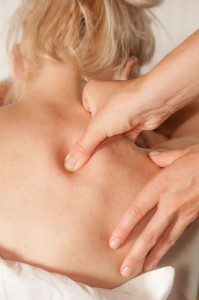Muscles account for more than 60% of the human body mass, making up the largest part of our bodies. They are responsible for all movement of the human body. With such an enormous responsibility, it is easy to see how muscles can be subjected to wear and tear, fatigue, overuse, and repetitive injury. When we want to move or use our muscles, the muscle contracts, and this is typically a voluntary action. However, sometimes the entire muscle contracts involuntarily, which we call a spasm.
Muscles are also subject to the condition known as Trigger Points, which is essentially an involuntary contraction of only a small portion of the muscle, creating pain and dysfunction within the muscle. One of the reasons that prescription muscle relaxants are ineffective on Trigger Points is that the medication would have to be strong enough to stop all involuntary muscle contractions…one incredibly important involuntary muscle—your heart—might not agree with this!
 Trigger Points: What They Are
Trigger Points: What They Are
Trigger Points have been studied and shown to be the most common cause of musculoskeletal pain. Pain clinic doctors have found that Trigger Points are the main source of pain nearly 75% of the time! Trigger Points cause the muscle to remain tight, which weakens the muscle and puts stress on the points where the muscles attach to the bones as well. This often leads to pain in nearby joints.
A unique feature that distinguishes Trigger Points from other muscle pain is that Trigger Points almost always refer pain to other areas of the body. This is why many treatments are ineffective. Most treatments assume that the area of pain should also be the source of pain, yet the actual cause could be in a completely different location. Trigger Points and their referred pain can be associated with many conditions, and may even cause some of them!
Trigger Points: The Effects
Trigger points can be formed through repetitive strain at work, in the office or playing sports, they can also occur due to an acute muscle spasm or fall. The difficulty in treating trigger points is that they typically send pain to some other area of the body. For example a trigger point in the upper traps or neck area can cause a headache towards the front of the head. But every trigger point has a regular pattern of referred pain, which makes it easy to fix.
Trigger points can be relieved and they will disappear with regular massage which can be done at home or in therapy. Knowing which points to target in certain areas can save a lot of unnecessary pain and panadol. Self applied trigger point massage for chronic problem areas can be taught and demonstrated for anyone to use at home for regular maintenance or for the one off headache. Trigger Point therapy can reduce pain, increase movement, and allows the muscles to lengthen and become stronger again.
To treat Trigger Points, heavy pressure must be applied to the Trigger Point. Light pressure is not effective for treating Trigger Points, and in fact may increase spasms as the muscle tries to protect itself, leading to increased and more constant pain. In contrast, moderate to heavy pressure applied to a Trigger Point causes the pain to initially increase, but then as the muscle relaxes the pain will fade. Pressure should be applied slowly and released slowly for best results. The pressure should be maintained until there is a change in pain. If there is no decrease in pain after one minute, stop the pressure—this is probably not a Trigger Point! After applying pressure to Trigger Points, the relaxed muscle should be stretched. If the muscles are not returned to normal length, there is a greater likelihood the Trigger Points will reoccur. Stretching is safer and less painful after the Trigger Points have been treated.





